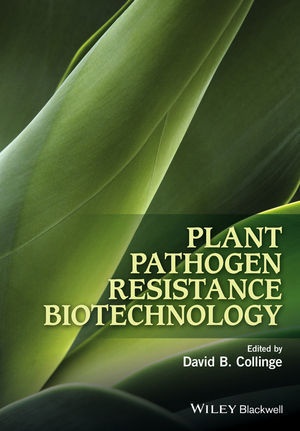Read more
Plant pathogens and diseases are among the most significant challenges to survival that plants face. Disease outbreaks caused by microbial or viral pathogens can decimate crop yields and have severe effects on global food supply. Understanding the molecular mechanisms underlying plant immune response and applying this understanding to develop biotechnological tools to enhance plant defense against pathogens has great potential for moderating the impact of plant disease outbreaks. Plant Pathogen Resistance Biotechnology's main focus is an in depth survey of the biological strategies being used to create transgenic disease resistant plants for sustainable plant resistance
Plant Pathogen Resistance Biotechnology is divided into four sections. The first section covers biological mechanisms underpinning disease resistance in plants, while the second highlights case studies of important pathogen-crop groups and then considers why the application of important pathogen-crop groups, transgenic-based strategies designed to selectively target pathogens could benefit crop production. The third section provides information on the status of transgenic crops around the world, and finally the last part explores high-tech alternatives to genetic engineering for developing disease resistant traits in plants. Edited and authored by leaders in the field, Plant Pathogen Resistance Biotechnology will be an invaluable resource to those studying or researching plant biotechnology, plant pathology, plant biology, plant and crop genetics, in addition to crop science.
List of contents
List of Contributors
Foreword
Acknowledgements
Chapter 1: The status and prospects for biotechnological approaches for attaining sustainable disease resistance
David B. Collinge, Ewen Mullins, Birgit Jensen and Hans JL Jørgensen
1.1 Introduction
1.2 Factors to consider when generating disease resistant crops
1.3 Opportunities to engineer novel cultivars for disease resistance
1.4 Technical barriers to engineering novel cultivars for disease resistance
1.5 Approaches for identification and selection of genes important for disease resistance
1.6 Promising strategies for engineering disease resistant crops
1.7 Future directions and issues
References
Part 1: Biological Strategies Leading Towards Disease Resistance
Chapter 2: Engineering barriers to infection by undermining pathogen effector function or by gaining effector recognition
Ali Abdurehim Ahmed, Hazel McLellan, Geziel Barbosa Aguilar, Ingo Hein, Hans Thordal-Christensen and Paul Birch
2.1 Introduction
2.2 Plant defence and effector function
2.3 Strategies for engineering resistance
2.4 Perspective
References
Chapter 3: Application of antimicrobial proteins and peptides in developing disease resistant plants
Ashis Kumar Nandi
3.1 Introduction
3.2 Biological role of PR-proteins
3.3 Anti-microbial peptides
3.4 Regulation of PR-protein expression
3.5 Biotechnological application of PR-protein genes in developing improved crop plants
3.6 Future directions
Acknowledgement
References
Chapter 4: Metabolic engineering of chemical defence pathways in plant disease control
Fred Rook
4.1 Introduction
4.2 Present status of metabolic engineering in the control of plant disease
4.3 Metabolic engineering: technical challenges and opportunities
4.4 The outlook for metabolically engineering of disease resistance in crops
References
Chapter 5: Arabinan: biosynthesis and a role in host-pathogen interactions
Maria Stranne and Yumiko Sakuragi
5.1 Introduction
5.2 Biosynthesis and modification of arabinan
5.3 Distribution of arabinan in different tissues and during development
5.4 Role of arabinan in plant growth and development
5.5 Roles of arabinan degrading enzymes in virulence of phytopathogenic fungi
5.6 Roles of arabinan in pathogen interactions
5.7 Conclusion
References
Chapter 6: Transcription factors that regulate defence responses and their use in increasing disease resistance
Prateek Tripathi, Aravind Galla, Roel C. Rabara and Paul J. Rushton
6.1 Introduction
6.2 Transcription Factors and Plant Defence
6.3 AP2/ERF Transcription factors
6.4 bZIP Transcription Factors
6.5 WRKY Transcription factors
6.6 MYB Transcription Factors
6.7 Other transcription factor families
6.8 Can the manipulation of specific transcription factors deliver sustainable disease resistance?
6.9 Have we chosen the right transgenes?
6.10 Have we chosen the right expression strategies?
6.11 What new ideas are there for the future of TF-based crop improvement?
References
Chapter 7: Regulation of abiotic and biotic stress responses by plant hormones
Dominik K. Großkinsky, Eric van der Graaff and Thomas Roitsch
7.1 Introduction
7.2 Regulation of biotic stress responses by plant hormones
About the author
David B. Collinge is a Professor of Plant Pathology in the Department of Plant Biology and Plant Biotechnology in the Faculty of Life Science at the University of Copenhagen.
Summary
Plant pathogens and diseases are among the most significant challenges to survival that plants face. Disease outbreaks caused by microbial or viral pathogens can decimate crop yields and have severe effects on global food supply.

